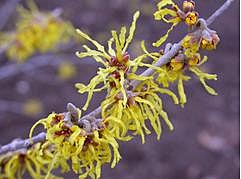Help Pollinators Fill Up with Early Spring Blooms
By Janet Scheren, Fairfax Master Gardener

Witch Hazel
You’ll often hear vegetable gardeners talk about the hunger gap — the time of year when winter crops have finally faded but before spring crops can sprout and ripen for harvest. But we’re not the only ones facing slim pickings this time of year. Bees and other pollinators find their nectar sources sparse and far between. As we head into winter, now’s the time to plan a beautiful early spring garden that will also ensure our beneficial winged friends can begin the season fully nourished to do their essential work, thrive and multiply.

Calendula
Start by assessing perennials, shrubs and trees you can add to your landscape that will provide early pollinator forage year after year. These include flowering fruit trees, hawthorn, redbud, maple, elm, poplar, willow, forsythia and witch hazel. Many early bulbs and native tuberous perennials are also part of pollinators’ early spring menu: Snow drops, early daffodils, grape hyacinth, woodland crocus and Claytonia virginica provide another early flush of pollinator friendly booms each year.
Next, add cool-season annuals to your plan. Among the earliest options for our mid-Atlantic, Zone 7 gardens are snapdragons, calendula, pansies, poppies, sweat peas and dianthus (Sweet William). Daikon radish can pull triple duty in your early spring garden — loosening your soil while providing a profusion of blooms for pollinators, and they are edible.
Broccoli flowering
Many of these cool-season hardy annuals actually prefer cool to cold temperatures; some can even survive below-freezing temperatures. These can be planted as early as six to eight weeks before the last expected spring frost. Some can be planted in fall to winter over. Start the more tender annuals indoors six to eight weeks before the last frost or buy transplants ready to plant after danger of frost. And don’t forget to let your early spring brassicas go to seed. Broccoli, mustard, cabbage and such all produce small yellow blossoms highly attractive to pollinators. Dandelions and similar interlopers can also provide early spring blossoms for our beneficial insects. All of this is even more important today because the use of pesticides and herbicides have decimated many of the open fields and blooming wildflowers they have depended on in the past.
Once we are past our frost free date in late April, a host of other blooms become sure bets for pollinators — salvia, nicotiana, cosmos, delphinium, hollyhock, larkspur and bee balm. Be sure to add those as early as possible to provide a continuum of food and keep those pollinators and beneficial insects in your garden. You’ll want them to stick around to pollinate your garden and patrol for pests all summer long.
In addition to nectar plants, it’s important to meet their other needs.
- Most of our native bees are ground nesters, so provide some areas in full sun where the soil is bare or slightly vegetated for those bees that nest in the ground.
- Plan a succession of blooms from early spring through late fall to keep these hard-working members of the insect family on your site.
- Realize that one size fits all doesn’t work for blossom size and color. Bees with short tongues can only access very open flowers. Those with long tongues can also get into long tubular flowers. Still other flowers require bees with strong body strength to open closed buds. Plant a wide variety of flower shapes and colors.
- Create a hospitable and comfortable environment for bees by ensuring you have garden layers that mimic nature. This should include a tree layer, an understory layer and an herbaceous layer.
Resources
• Vegetables Love Flowers, by Lisa Mason Ziegler
• Grow Great Virginia Vegetables by Ira Wallace
• Plant Bee Flowers, Bee Lab, University of Minnesota Bee Squad, College of Food, Agricultural and
Natural Resource Sciences
• Bee Friendly Flowers, Charlotte Glen, Horticulture Agent, NC Cooperative Extension, Pender
County Center